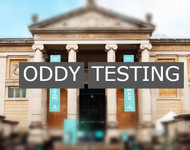The Oddy Test for Heritage and Museum Safe Paints
Posted by Sarah, Celtic Sustainables on 12th Oct 2023
The Oddy Test serves as a crucial tool in ensuring the protection and preservation of our culturally significant artefacts and artwork.

The Oddy Test was created by Andrew Oddy, who was working at the British Museum in 1975,
Oddy Test, what is it?
An Oddy Test is a corrosion test that helps determine if materials such as paint, wood and fabrics are safe to use with objects housed in enclosed spaces, such as museums, galleries, and heritage sites. It is an accelerated ageing test used to predict the likelihood of a material causing corrosion of artwork, artefacts, or other heritage pieces, which react to potentially hazardous gases (Volatile Organic Compounds – VOCs).
VOCs used in confined spaces can off-gas from materials and, therefore, can harm organic matter or corrode metal objects that are on display.
Materials testing with the Oddy Test is crucial in making sure that materials used in showcases, packing crates, or storage areas are safe for the objects they contain.
How to Test for Potential Damage to Decorative Metals
To perform the Oddy Test, a sample is placed inside a sealed container along with three metal coupons (silver, copper, and lead) and a small amount of water in an open vial. The container is then kept at a temperature of 60 degrees Celsius for 28 days to maintain a relative humidity of 95 to 100%.
Museum-safe paint is suitable for all projects!
Graphenstone Paints Pass the Oddy Test
Graphenstone Paints got the Oddy certification some years ago and was of recent interest to the Ashmolean Museum. The Ashmolean Museum is the University of Oxford’s Museum of art and archaeology. Britain’s first public museum is home to half a million years of human history and creativity, from ancient Egyptian mummies to modern art. In collaboration with Graphenstone, they used the paints in key areas throughout the museum, safe in the knowledge that they also have the additional benefit of the Oddy certificate.
Graphenstone Paints that passed the Oddy Test:
- Graphenstone - GCS Interior Premium
- Graphenstone - Ecosphere Interior Paint
Earthborn’s Museum safe paints pass the Oddy Test.
“As Earthborn paints contain virtually zero VOCs, we were certain they would be safe to use. We wanted the reassurance of the Oddy Test so that contractors and specifiers could confidently use Earthborn paints for the heritage projects they are working on. This provides not only peace of mind but a guarantee that our paints will not affect the objects on display.”
Hasting Contemporary Gallery is an Art Gallery doing its part to help the environment by utilising sustainable technology such as ground-source cooling, solar panels, and recycled water. It's important to them to be responsible stewards of the planet, and they hope to inspire others to do the same. Therefore, a natural partnership was born when Earthborn was approached to be the official paint sponsor for Hastings Contemporary Art Gallery's newest exhibition, the first-ever public viewing of the work of Korean artist Yun Hyong-keun in the UK.
Earthborn paints that have been through the Oddy test and passed:
All passed with flying colours and are officially museum quality that can be used in similar situations in heritage buildings. Because the Earthborn paint is virtually VOC-free, no nasty chemicals will affect or potentially harm the artwork or any objects on display.
Keim and VOC FREE Paint suitable for Heritage installation
KEIM paints do not have the Oddy Test certification reports. However, they can provide documents confirming no presence of solvents, aromatic hydrocarbons, lead, arsenic, mercury, formaldehyde, etc., within the KEIM mineral Interior paints.
Paints that are suitable for heritage and new builds and have the Cradle-to-Cradle Certification.
- Keim - Ecosil ME Interior Silicate Paint
- Keim - Innostar one-coat interior silicate paint
- Keim - Optil Interior Silicate Paint





